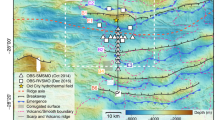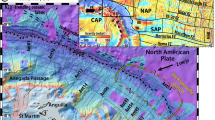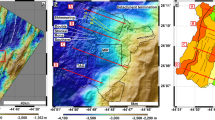Abstract
Oceanic core complexes are massifs in which lower-crustal and upper-mantle rocks are exposed at the sea floor1,2,3. They form at mid-ocean ridges through slip on detachment faults rooted below the spreading axis2,3,4,5,6. To date, most studies of core complexes have been based on isolated inactive massifs that have spread away from ridge axes. Here we present a survey of the Mid-Atlantic Ridge near 13° N containing a segment in which a number of linked detachment faults extend for 75 km along one flank of the spreading axis. The detachment faults are apparently all currently active and at various stages of development. A field of extinct core complexes extends away from the axis for at least 100 km. Our observations reveal the topographic characteristics of actively forming core complexes and their evolution from initiation within the axial valley floor to maturity and eventual inactivity. Within the surrounding region there is a strong correlation between detachment fault morphology at the ridge axis and high rates of hydroacoustically recorded earthquake seismicity. Preliminary examination of seismicity and seafloor morphology farther north along the Mid-Atlantic Ridge suggests that active detachment faulting is occurring in many segments and that detachment faulting is more important in the generation of ocean crust at this slow-spreading ridge than previously suspected.
This is a preview of subscription content, access via your institution
Access options
Subscribe to this journal
Receive 51 print issues and online access
$199.00 per year
only $3.90 per issue
Buy this article
- Purchase on Springer Link
- Instant access to full article PDF
Prices may be subject to local taxes which are calculated during checkout




Similar content being viewed by others
References
Cann, J. R. et al. Corrugated slip surfaces formed at ridge–transform intersections on the Mid-Atlantic Ridge. Nature 385, 329–332 (1997)
Tucholke, B. E., Lin, J. & Kleinrock, M. C. Megamullions and mullion structure defining oceanic metamorphic core complexes on the Mid-Atlantic Ridge. J. Geophys. Res. 103, 9857–9866 (1998)
Blackman, D. K., Cann, J. R., Janssen, B. & Smith, D. K. Origin of extensional core complexes: Evidence from the Mid-Atlantic Ridge at Atlantis Fracture Zone. J. Geophys. Res. 103, 21315–21333 (1998)
MacLeod, C. J. et al. Direct geological evidence for oceanic detachment faulting: The Mid-Atlantic Ridge, 15°45′ N. Geology 30, 279–282 (2002)
Escartín, J., Mével, C., MacLeod, C. J. & McCaig, A. M. Constraints on deformation conditions and the origin of oceanic detachments: The Mid-Atlantic Ridge core complex at 15°45′ N. Geochem. Geophys. Geosyst. 4, 1067, doi:10.1029/2002GC000472 (2003)
Searle, R. C. et al. FUJI Dome: A large detachment fault near 64 degrees E on the very slow-spreading Southwest Indian Ridge. Geochem. Geophys. Geosyst. 4, doi:10.1029/2003GC000519 (2003)
Dick, H. J. B., Thompson, W. B. & Bryan, W. B. Low angle faulting and steady-state emplacement of plutonic rocks at ridge–transform intersections. Eos 62, abstr. 406 (1981)
Karson, J. A. & Dick, H. J. B. Tectonics of ridge–transform intersections at the Kane Fracture Zone. Mar. Geophys. Res. 6, 51–98 (1983)
Schroeder, T. & John, B. E. Strain localization on an oceanic detachment fault system, Atlantis Massif, 30 degrees N, Mid-Atlantic Ridge. Geochem. Geophys. Geosyst. 5, 1–30 (2004)
Christie, D. M., West, B. P., Pyle, D. G. & Hanan, B. B. Chaotic topography, mantle flow and mantle migration in the Australian–Antarctic Discordance. Nature 394, 637–644 (1998)
Okino, K., Matsuda, K., Christie, D., Nogi, Y. & Koizumi, K. Development of oceanic detachment and asymmetric spreading at the Australian–Antarctic Discordance. Geochem. Geophys. Geosyst. 5, doi:10.1029/2004GC000793 (2004)
Escartín, J. & Cannat, M. Ultramafic exposures and the gravity signature of the lithosphere near the Fifteen-Twenty Fracture Zone (Mid-Atlantic Ridge, 14°–16.5°N). Earth Planet. Sci. Lett. 171, 411–424 (1999)
Ohara, Y., Yoshida, T. & Kasuga, S. Giant megamullion in the Perece Vela Backarc basin. Mar. Geophys. Res. 22, 47–61 (2001)
Cannat, M. et al. Thin crust, ultramafic exposures, and rugged faulting patterns at the Mid-Atlantic Ridge (22°–24°N). Geology 23, 49–52 (1995)
Blackman, D. K. et al. Geology of the Atlantis Massif (Mid-Atlantic Ridge, 30°N): Implications for the Evolution of an Ultramafic Oceanic Core Complex. Mar. Geophys. Res. 23, 443–460 (2003)
Tucholke, B. E., Fujioka, K., Ishihara, T., Hirth, G. & Kinoshita, M. Submersible study of an oceanic megamullion in the central North Atlantic. J. Geophys. Res. 106, 16145–16161 (2001)
Spencer, J. E. Geologic continuous casting below continental and deep-sea detachment faults and at the striated extrusion of Sacsayhuaman, Peru. Geology 27, 327–330 (1999)
Macdonald, K. C. Mid-ocean ridges: Fine scale tectonic, volcanic, and hydrothermal processes within the plate boundary zone. Annu. Rev. Earth Planet. Sci. 10, 155–190 (1982)
Smith, D. K. et al. Hydroacoustic monitoring of seismicity at the slow-spreading Mid-Atlantic Ridge. Geophys. Res. Lett. 29, doi:10.1029/2001GL013912 (2002)
Bohnenstiehl, D. R., Tolstoy, M., Dziak, R. P., Fox, C. G. & Smith, D. K. Aftershock sequences in the mid-ocean ridge environment: An analysis using hydroacoustic data. Tectonophysics 354, 49–70 (2002)
Fox, C. G., Matsumoto, H. & Lau, T.-K. Monitoring Pacific ocean seismicity from an autonomous hydrophone array. J. Geophys. Res. 106, 4183–4206 (2001)
Smith, D. K. et al. Spatial and temporal distribution of seismicity along the northern Mid-Atlantic Ridge (15°–35°N). J. Geophys. Res. 108, doi:10.1029/2002JB001964 (2003)
Escartin, J., Smith, D. K. & Cannat, M. Parallel bands of seismicity at the Mid-Atlantic Ridge, 12–14N. Geophys. Res. Lett. 30, doi:10.1029/2003GL017226 (2003)
Fujiwara, T. et al. Crustal evolution of the Mid-Atlantic Ridge near the Fifteen-Twenty Fracture Zone in the last 5 Ma. Geochem. Geophys. Geosyst. 4, 1024, doi:10.1029/2002GC000364 (2003)
Smith, W. H. F. & Sandwell, D. T. Global sea floor topography from satellite altimetry and ship depth soundings. Science 277, 1956–1962 (1997)
Sudarikov, S. M. & Roumiantsev, A. B. Structure of hydrothermal plumes at the Logatchev vent field, 14 45′ N, Mid-Atlantic Ridge: evidence from geochemical and geophysical data. J. Vol. Geotherm. Res. 101, 245–252 (2000)
Acknowledgements
We are grateful to the captain and crew of the RV Knorr (Leg 182, 2005). We are also grateful to P. Lemmond, H. Schouten and M. Tivey for their help in collecting the data at 13° N. We had fruitful discussions with R. Searle, H. Schouten, M. Tivey and R. Sohn. We also thank J. Goff for constructive comments on the manuscript. This work was supported by the National Science Foundation. This is an IPGP contribution.
Author information
Authors and Affiliations
Corresponding author
Ethics declarations
Competing interests
Reprints and permissions information is available at npg.nature.com/reprintsandpermissions. The authors declare no competing financial interests.
Rights and permissions
About this article
Cite this article
Smith, D., Cann, J. & Escartín, J. Widespread active detachment faulting and core complex formation near 13° N on the Mid-Atlantic Ridge. Nature 442, 440–443 (2006). https://doi.org/10.1038/nature04950
Received:
Accepted:
Issue Date:
DOI: https://doi.org/10.1038/nature04950
This article is cited by
-
Geophysical investigation of the Mado Megamullion oceanic core complex: implications for the end of back-arc spreading
Progress in Earth and Planetary Science (2023)
-
How transform fault shear influences where detachment faults form near mid-ocean ridges
Scientific Reports (2023)
-
Microbathymetry inferences from two AUV dives over a short segment of the Central Indian Ridge between 10°18′ and 10°57′S, Indian Ocean
Geo-Marine Letters (2023)
-
Generation and evolution of the oceanic lithosphere in the North Atlantic
La Rivista del Nuovo Cimento (2022)
-
Fossil oceanic core complexes in the Alps. New field, geochemical and isotopic constraints from the Tethyan Aiguilles Rouges Ophiolite (Val d’Hérens, Western Alps, Switzerland)
Swiss Journal of Geosciences (2021)
Comments
By submitting a comment you agree to abide by our Terms and Community Guidelines. If you find something abusive or that does not comply with our terms or guidelines please flag it as inappropriate.



